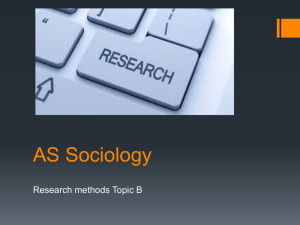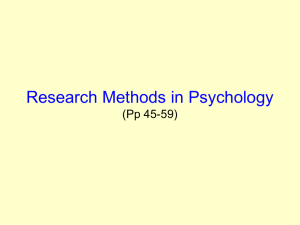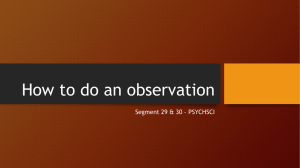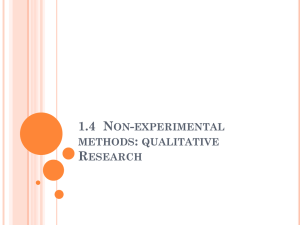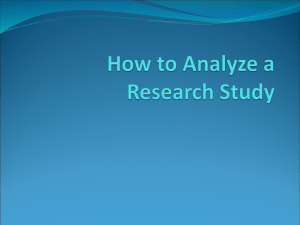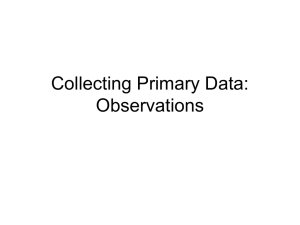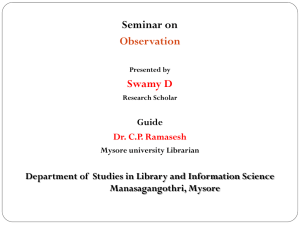Participant observation and the pursuit of truth
advertisement
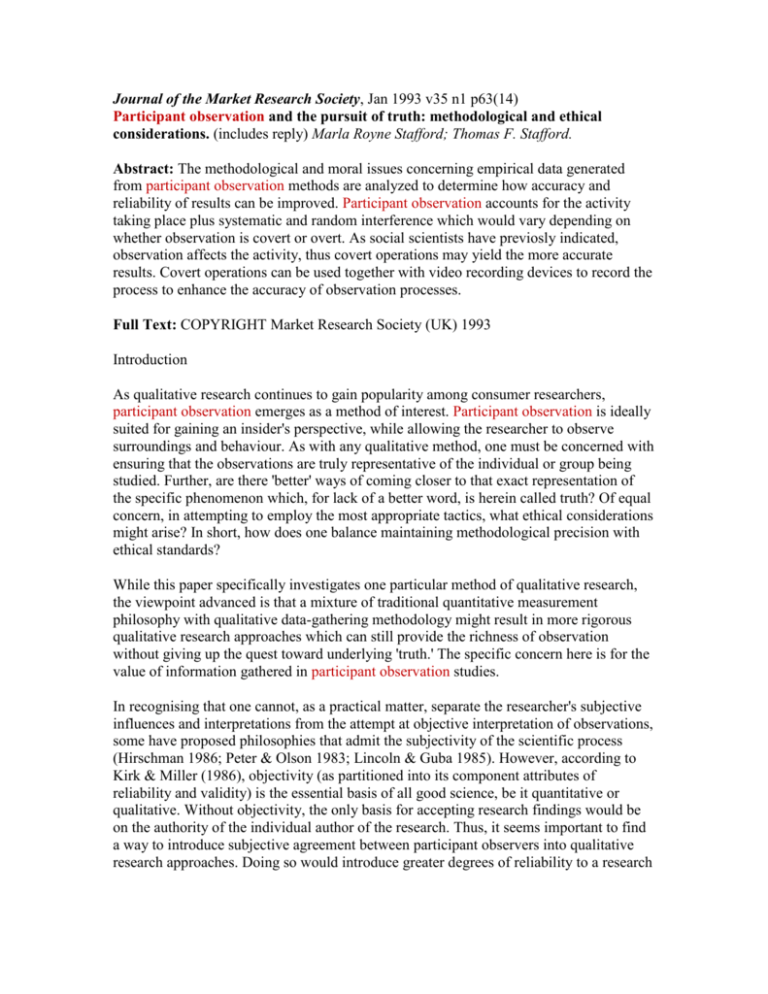
Journal of the Market Research Society, Jan 1993 v35 n1 p63(14) Participant observation and the pursuit of truth: methodological and ethical considerations. (includes reply) Marla Royne Stafford; Thomas F. Stafford. Abstract: The methodological and moral issues concerning empirical data generated from participant observation methods are analyzed to determine how accuracy and reliability of results can be improved. Participant observation accounts for the activity taking place plus systematic and random interference which would vary depending on whether observation is covert or overt. As social scientists have previosly indicated, observation affects the activity, thus covert operations may yield the more accurate results. Covert operations can be used together with video recording devices to record the process to enhance the accuracy of observation processes. Full Text: COPYRIGHT Market Research Society (UK) 1993 Introduction As qualitative research continues to gain popularity among consumer researchers, participant observation emerges as a method of interest. Participant observation is ideally suited for gaining an insider's perspective, while allowing the researcher to observe surroundings and behaviour. As with any qualitative method, one must be concerned with ensuring that the observations are truly representative of the individual or group being studied. Further, are there 'better' ways of coming closer to that exact representation of the specific phenomenon which, for lack of a better word, is herein called truth? Of equal concern, in attempting to employ the most appropriate tactics, what ethical considerations might arise? In short, how does one balance maintaining methodological precision with ethical standards? While this paper specifically investigates one particular method of qualitative research, the viewpoint advanced is that a mixture of traditional quantitative measurement philosophy with qualitative data-gathering methodology might result in more rigorous qualitative research approaches which can still provide the richness of observation without giving up the quest toward underlying 'truth.' The specific concern here is for the value of information gathered in participant observation studies. In recognising that one cannot, as a practical matter, separate the researcher's subjective influences and interpretations from the attempt at objective interpretation of observations, some have proposed philosophies that admit the subjectivity of the scientific process (Hirschman 1986; Peter & Olson 1983; Lincoln & Guba 1985). However, according to Kirk & Miller (1986), objectivity (as partitioned into its component attributes of reliability and validity) is the essential basis of all good science, be it quantitative or qualitative. Without objectivity, the only basis for accepting research findings would be on the authority of the individual author of the research. Thus, it seems important to find a way to introduce subjective agreement between participant observers into qualitative research approaches. Doing so would introduce greater degrees of reliability to a research paradigm that has traditionally favoured richness at the expense of reliability (Deshpande 1983). Qualitatively-orientated philosophers suggest that objectivity has been sought but not achieved. Qualitative research, in general, (Calder 1977) and, specifically, participant observation (Bouchard 1976), are subject to inherent threats to validity. On the one hand, since reliability and validity are so interrelated, increasing the former might also improve the latter (Peter 1981). On the other hand, it is suggested that the inherent characteristics of qualitative research are not conducive to reliability. While one might be able to replicate data, interpretations of those data might differ. Sykes (1990) proposes an exacting documentation process for observational naturalistic research, reasoning that detailed documentation would enable other researchers to 'replicate' the findings of particular studies, thereby solving, if only in part, the reliability problem. It seems that there might be some advantage to be gained by integrating certain approaches to 'truth' with some quantitative measurement philosophies for increasing rigour in research. The goal here would be to increase the understanding of the observations made in qualitative research, especially participant observation. To that end, the purposes of this paper are to discuss: (1) the empirical concerns for the assessment of 'truth' in participant observation; (2) the various trade-offs, in terms of ethics and 'truth value,' involved in the differing levels of participant observation; and (3) the use of recording devices in participant observation as an aid to more accurately assessing 'truth' and the ethical issues that arise from their use. Participant observation and the 'truth' of findings Whilst traditional quantitative, research perspectives tend to favour measurement quality, or what Deshpande (1983) terms reliability, and qualitative approaches tend to favour richness of data, which is analogous to validity (Deshpande 1983), the norms for good science also dictate that social science research should exhibit both qualities (Kirk & Miller 1986; Hunt 1984). However, if one accepts the suggestion to mix methods from both qualitative and quantitative paradigms (Bouchard 1976; Deshpande 1983), then it appears that one of the most useful concepts that could be brought to qualitative methodology is that of measurement theory, as outlined by Churchill (1979). In relating his paradigm for better measures of marketing constructs, Churchill offers the following conceptualisation of the components of observation: !X.sub.O^ = !X.sub.T^ + !X.sub.S^ + !X.sub.R^ The meaning of this model is simple: what we observe is a combination of the 'true' phenomenon actually taking place, plus a combination of systematic and random interference (ie, error) with our attempts to observe the phenomenon. The significance of this basic conceptualisation of the process of measurement is in the deliberate and specific recognition of interfering factors. This view is not incompatible with the qualitative approach. While those who advocate qualitative methods might argue with the ultimate nature of 'truth,' they, too, concede that errors are inherent in observations (Hunt 1984). By the recognition of inherent error, one is forced specifically to recognise the factors which intrude upon observational accuracy, rather than ignoring them and hoping that they will simply go away. Some qualitative scientists, in proposing that truth is situational and contextual, could fall into the trap of thinking that one can never begin to understand a specific phenomenon at a more basic, 'true' level. In addition, it is possible that by relying on subjective interpretation alone, and ignoring the inherent nature of error, qualitative scientists could be greatly increasing the !X.sub.s^ (systematic error or bias) component of measurement in their studies. This could happen when researchers allow personal beliefs and individual biases to intrude upon what should rightly be a purely objective process of data gathering and interpretation. Very simply, with qualitative methods such as participant observation, it is impossible on a practical level to separate the gathering of data from their interpretation. As such, the danger of bias exists without sufficient checks on interpretation. What value does biased observation have if scientists fail to recognise and attempt to account for that bias? Is this 'truth'? Probably not, even if consensus can be built around the biased observations. As previously noted, reliability is a weak element in qualitative research; it is a trade-off for the richness of data obtained. In participant observation, the observer becomes the instrument. The ability of the observer consistently to observe and interpret phenomena, or to agree with other observers about those phenomena, is the key to better levels of reliability in participant observation, and through this, a better understanding of the phenomena being studied. Truth may depend on the situation or context, but this does not necessarily mean that a better understanding or a more accurate approximation of 'the truth' cannot be shared by several similarly trained observers of the same specific phenomenon. Jorgensen (1989) indicates that the use of multiple observers together with the ability to independently replicate the study and verify procedures can increase 'dependability' and 'trustworthiness' of participant observation. Similarly, Sykes (1990) observes that 'consultative validity' can be achieved by involving other investigators in the interpretation of observational findings. Similarly trained scientists should arrive at equivalent interpretations and thereby increase one's confidence in the 'truth' of what they have seen. It is worth considering the possibility that methods which can aid in the 'replication' of qualitative observations and interpretations of phenomena can contribute greatly to the 'truth value' of research findings in participant observation. With the introduction of greater levels of reliability through the process of independent verification, one component in the Churchill (1979) model for better measures is bolstered: reliability in measurement decreases random error, subsequently increasing the accuracy of the observation. An increase in the reliability of observational interpretations also increases validity, bringing one closer to an understanding of the 'true' phenomena of study. There might also be specific methods one can consider for control of Churchill's other error component. Systematic variation relates to bias factors introduced either by the subjects' reactions to the presence of the researcher or the researcher's interpretation of the phenomenon under study. These issues are equally important and will be addressed below. Overt vs covert participant observation Overall, participant observation allows for two major categories of research: overt and covert. When the researcher openly requests permission to observe a situation, and plans to make his or her identity, objectives, and intentions known, the research is considered overt. Overt research is generally considered ethically acceptable, but it is also considered obtrusive, leading to two problems: (1) the researcher may be refused access, causing subsequent research attempts to be denied; or (2) even if access is granted, subjects may react to the researcher's presence. As the latter is of most concern here, discussion will centre on this issue. The effects of observation on subjects Numerous social scientists have recognised that a primary problem in overt research is 'reactivity,' or subjects' reactions to the knowledge that they are being observed (Bouchard 1976; Kidder, Judd & Smith 1986; Neale & Liebert 1980; Schuler 1982; Kazdin 1982). Neale & Liebert (1980) assert that the act of observation itself may produce changes in the phenomenon being studied and that this problem is hardly unique in social science research. They state: "the presence of such reactions may render the obtained results unrepresentative of the natural situation in which the investigator is ultimately interested....any such situation may be referred to as a reactive arrangement." (Neale & Liebert 1980, p 44) The effects of reaction to observation are particularly well-illustrated by the Hawthorne Studies. During the late 1920s and early 1930s, employees at the Hawthorne plant of the Western Electric Company were observed in a study examining worker productivity. Various treatments were introduced into working conditions (eg lighting changes, work hour changes). No matter which treatment was employed, worker productivity increased (Neale & Liebert 1980). Even the control groups, who received no treatment at all, experienced an increase in productivity (Griffin 1987). This increase in performance due to one's knowledge of being observed became known as the Hawthorne Effect. This reaction effect can occur when any aspect of the investigation causes the subject to act upon what he or she believes is expected or desired of him or her. In short, bias may result if the true purpose of the research is discovered or if it becomes known that researchers are making observations. This bias corresponds to the systematic error identified in Churchill's (1979) model of the components of observation. Kazdin (1982) states that direct observation has its own source of bias, and Robson & Wardle (1988) report that a comparison of two groups -- one observed and one not observed -- resulted in the observed group responding with answers that were shallower, more compromised, more moderate and more superficial. In short, less 'truthful' answers were obtained. Neale & Liebert (1980) suggest that the researcher create a situation where subjects are involved in everyday activities and are not aware that they are participants in a scientific investigation. Schuler (1982) proposes complete participation, where the researcher assumes a fictitious identity. Such concerns with overt research techniques build a persuasive argument for the utilisation of covert techniques, where the researcher becomes an 'insider.' In this case, the true identity of the researcher remains concealed, and subjects believe the individual to be a new member of their group. Since group members are unaware of being observed, data generated by such methods are not contaminated by respondent reaction (Bouchard 1976). As a result, the truth value of the observations is greatly increased. Ethical considerations While covert techniques may lead to greater precision and greater truth value in qualitative research, there are ethical concerns, particularly over the deceptive nature of such approaches. As a result, many researchers question their use. Deception in the use of covert techniques may take two forms: (1) the subjects being studied are not informed of the research; and (2) because they are unaware of the research, subjects are not asked for the traditionally required 'informed consent.' For these reasons, some researchers maintain that covert strategies violate the rights of human subjects, particularly the right to informed consent. However, since the notion of informed consent was developed after the Nuremberg trials of war criminals charged with carrying out extreme medical experiments during World War II, some researchers argue that such consent is not applicable in observational research where the intent of the researcher is not harmful (Bulmer 1982). On the other hand, if deception is finally disclosed, future research in that setting or environment may not be practical. Once the trust has been violated, it is usually impossible to reinstate it. Furthermore, the reputation of colleagues in the field may be placed at risk when such deceptive tactics are revealed. According to Homan & Bulmer (1982), concerns over deception, violation of trust, and the possibility of damage to the reputation of the discipline as a result of the use of these tactics is not limited to covert methodology; they are probable hazards in overt investigations as well. In advocating covert techniques, some researchers indicate that their use is essential to acquiring truthful information (cf, Jorgensen 1989). Douglas (1976) believes that most human research would be virtually meaningless if participant observers were required to reveal their intentions and argues that covert research is a necessary, useful and revealing method. Jorgensen (1989) notes that the limited access which accompanies more overt tactics generally results in less valid and less reliable findings. For this reason, some participant observers defend covert strategies, reasoning that there are important aspects of human existence that cannot be known except from the inside. Denzin (Denzin & Erikson 1982) argues that revealing the purpose of the investigation is unnecessary, and informed consent need not be sought. He states that social scientists: "have the right to make observations of anyone in any setting to the extent that he (sic) does so with scientific intent and purpose. Any method that moves us toward advancement of knowledge in science without unnecessary harm to subjects is justifiable. The method must not damage credibility or reputation of the subject, and the researcher must take pains to maintain the integrity and anonymity of the subjects." (Denzin & Erikson 1982, p143) Hodges (1988) outlines the conditions under which deception is acceptable. Though his work was directed toward journalists, one can easily liken the work of participant observers with that of reporters, since both are trying to explain a set of events. The first condition is that the information sought must be of overriding public importance. Secondly, there should be no reasonable likelihood that comparably accurate and reliable information could be obtained as efficiently through conventional investigative techniques. And thirdly, the proposed deception must not place innocent people at serious risk. The question of whether a particular research project is of overriding public importance is admittedly subjective, but most researchers would certainly maintain the (subjective) importance of their own work. With regard to the second requirement, the additional use of covert documentation provides for more accurate (thus, more reliable and ultimately more valid) information that can be obtained through participant observation, alone. Thirdly, most ethical social scientists do not wish to harm subjects (Bulmer 1982; Jorgensen 1989). In marketing research, additional protection is provided by at least two professional codes of ethics which strictly prohibit researchers from placing any individual at risk for purposes of advancing the discipline; these ethical codes are published by the American Marketing Association (1991) and The Market Research Society (1992). Of the two organisations, only The Market Research Society has something substantial to say specifically on participant observation. For example, covert participant observation should only take place without participants' permission when they are in a situation where they might reasonably expect to be seen or heard (Code of Conduct, Rule A14, The Market Research Society, 1992). Standard and more general prohibitions against the unauthorised release or misuse of data are provided by the American Marketing Association and are echoed by The Market Research Society in Rule A2, which specifies that outside access to research data be limited to cases of data processing and validity checks. Levels of participant observation: methodological give and take While the two general types of participant observation include the polar views of overt versus covert, one can look further and examine the various types or levels of observation. These four levels range along a continuum of complete participant, participant-as-observer, observer-as-participant and complete observer (Babbie 1986; Bouchard 1976; Jorgensen 1989). Of these four, three are considered overt techniques, and one, complete participation, is covert. As mentioned above, a researcher employs complete participation by surreptitiously becoming a member of the group under study. Although complete participation is potentially the most deceptive level of participation, it has already been noted that such research is generally pursued based on the belief that the data will be of greater value. If a researcher remains a member of the group for an extended period of time, more accurate and valuable information can be obtained (Bouchard 1976; Hirschman 1986). Not only will subjects continue to exist and interact normally, but the researcher will be able to achieve a deeper understanding of the meaning of the phenomena being studied. For example, a consumer researcher studying buyer/seller relationships in a retail setting may accept a position as a salesperson in order to become integrated into the group. Through actual participation, the researcher can become part of the process and consequently, achieve a deeper understanding of the buyer/seller relationship. In a similar vein, an advertising agency developing a beer campaign might send an agency employee out to a local pub to become friends with the patrons. By becoming a member of the group, the employee can learn about aspects of beer consumption that he, otherwise, might never be exposed to. In the role of participant-as-observer, the researcher is able to admit the investigative role (alleviating the problem of deception), while still maintaining membership in the group. At this level, the researcher participates fully in all activities of the group. However, subjects are completely aware of being under observation, so the danger exists that they may shift their attention to the research project itself rather than focusing on their natural behaviour; thus, the processes studied may not be typical (Babbie 1986). Such might be the case in focus group research where a moderator is present with the group. In the role of observer-as-participant, the researcher identifies himself and attempts to interact with the group. He does not, however, participate in group activities, and he relies mostly on informants. Such a method was utilised by Belk, Sherry & Wallendorf (1988) in their naturalistic investigation of consumer behaviour at a swap meet. Here, the researchers used overt observation as a means of understanding exchange at a unique retail outlet. Although observer as participant raises no ethical debate, little social interaction transpires, because it is only through participation that the researcher is able to observe and experience the meanings and interactions of people (Jorgensen 1989). In short, the effect of a low level outsider on respondents is difficult to evaluate (Bouchard 1976). How, then, can one truly assess the 'truth' of findings from such an approach? The approaches of participant-as-observer and observer-as-participant do offer an important advantage: the researcher is able to assume a 'stranger' role and ask questions from a position of ignorance, a benefit not available when employing covert strategies (Homan & Bulmer 1982). Nevertheless, the researcher may find subjects attempting to answer 'correctly' or 'acceptably,' which can cause bias in their answers. One can, again, question the 'truth' of these responses. Complete observation, though included in most discussions of participant observation, is simply watching or observing from a distance. The researcher is isolated completely from the phenomena, allowed no direct contact or interplay. For example, complete observation can be used for monitoring purchase behaviour in retail stores. Two advantages of such an approach are a lack of ethical conflicts because observation is occurring in a public place (Hirschman 1986), and few respondent reactions to the research since an unobtrusive measure is being utilised. However, information obtained from this approach lacks richness and details (Hirschman 1986; Babbie 1986) and has the potential for misunderstanding and inaccuracy (Jorgensen 1989). Finally, although public observation may be ethically sanctioned, subjects remain unaware that they are being observed. So, the issue of informed consent arises once again, though without the mitigating value that the quality of participant observation data might bring. The requirements, discussed earlier, for informed consent or the 'reasonable expectation' exception of Rule A15 (The Market Research Society Code of Conduct) are worth remembering in this context. Difficulty exists in attaining a balance between truth-value and ethics. If complete participation is employed, truth and interpretive understanding may be achieved, but the researcher might face ethical restrictions. This will of course depend on the circumstances (recall again the 'reasonable expectation' requirements). Should participant-as-observer be selected, the researcher may not face an ethical dilemma, but reactions and bias may be generated, and deep understanding may not be achieved. In observing as a participant, the researcher maybe relieved of ethical concerns, but might fail to achieve shared meanings or a full understanding of the phenomenon of study. Finally, as a complete observer, simple facts may be discerned, but no rich interpretation may be realised. If qualitative researchers are seeking to maximise 'truth value' in observational data, they must not be afraid to consider the same rigorous precepts of traditional scientific inquiry. If choosing the method that will provide the 'truest' assessment of the phenomenon in question means selecting a covert strategy, naturalists must not be afraid of utilising this method when the research problem demands it. Recording devices: alternatives for record keeping If one does justify the use of covert methods and selects this option in participant observation, the subsequent issue of accurate documentation arises. Observations must be recorded as quickly as possible and with the greatest possible detail (Jorgensen 1989) to attain the desired level of 'truth.' If timely documentation is impossible, one questions how much of the data can actually be remembered and transcribed later. Here, the question of reliability in qualitative research arises again. And in this situation, the random effects of memory decay might be analogous to random error. Traditionally, pencil and paper have been used to record observations and interpretations. However, in both overt and covert strategies, pencil and paper instruments become an impediment. If the researcher assumes an insider role, group members might question his or her visible note-taking, leading to suspicion and a lack of trust. For overt researchers, subjects might become uncomfortable with the idea that their personal thoughts are being transferred to a permanent record. It is possible that subjects will once again fail to respond 'truthfully' for fear of reprisal or potential embarrassment. An alternative to paper and pencil instruments is recording technology. Researchers have long practiced the audio and video recording of focus group encounters as an aid to documentation and interpretation of findings. The use of 'hidden camera' techniques in the production of testimonial advertisements for consumer goods is also fairly familiar. Now, audio and video recording devices are also generally advocated for use in field research. Indeed, some researchers believe they are invaluable for this type of research, as such equipment produces an accurate and detailed record (Albrecht 1985; Jorgensen 1989), which can serve as an aid to memory. Such was the case with Pennington's (1968) research on the nature of the transaction between home appliance sellers and buyers. Since the transaction was the unit of analysis, a complete and accurate record of the entire interaction between buyer and seller was necessary. For this reason, the researcher equipped the salespersons with a hidden miniature microphone to record the entire transaction. Tapes can also help to increase 'truth value' by increasing the accuracy and the ability to draw generalisations from interpretative data. As discussed earlier, one part of systematic error may arise from the researcher's interpretation of the phenomenon. With a permanent record, the researcher's interpretation can be confirmed by other investigators who have the opportunity to view/hear the record. This allows for the opportunity to identify, and thereby, control or eliminate systematic error. For example, Olshavsky (1973) undertook additional analysis of the buyer/seller transactional recordings produced by Pennington (1968) in his study of retail appliance sales. A lasting record also introduces consensus building techniques into participant observation, increasing reliability through observer agreement over the phenomena and interpretations. By controlling random and systematic sources of error in participant observation, one can get closer to that desired truth. Therefore, the use of recording devices as an enhancement to traditional memory and note-taking approaches to documentation should help to achieve these ends. When overt measures are employed, however, tape recorders and audio-visual equipment often become obtrusive (Albrecht 1985; Jorgensen 1989). For example, one might question the veracity of findings in research studies such as the ones by Stoneman & Brody (1983) and Anderson et al (1986), where television viewing behaviour was documented by video recording over time in the home. While the results of the studies are certainly valuable and interesting, there is concern that the obvious presence of scientific recording devices may have impacted subject behaviour. Similarly, Hill's (1992) study on homelessness and consumer behaviour similar utilised tape recordings in a situation where the researcher openly became the interviewer. Belk, Sherry & Wallendorf (1988) offer yet another example involving overt recording wherein the researchers actively integrated the video camera into the overt observer-as-participant format of the research. Here, the researchers were present primarily as observers rather than as complete participant observers, and as one example of possible subject reaction, they noted that subjects would approach the researchers at the camera and ask to be recorded. This reminds one of the rather contrived and exhibitionistic behaviour that often occurs in the presence of live crowd-action news camera coverage. In other words, just as one can expect subjects to react to the use of obtrusive measures, subject reactions can also be expected to occur when recording devices are employed (Albrecht 1985). These reactions can often act to contaminate the quality of the behaviour under study. It is, therefore, suggested that the most accurate assessment of truth can be obtained through surreptitious recording as an interpretational check (by providing a record for others to interpret for consensus purposes), and as a source of documentation to aid the participant observer in verifying his or her own subjective memory of the events. Ethical considerations Just as covert surveillance is highly controversial, so is the use of concealed recorders. Bouchard (1975) and Jorgensen (1989) acknowledge that the existence of smaller, minicassette recorders make them suitable for such work. Hodges (1988) and Albrecht (1985) also recognise the need for recording devices with the latter pointing out: "video methods not only capture the behavior representing social structures, but also express the diversity and idiosyncracies of behavior...research becomes an interactive process full of surprises when recording behavior with a camera. Videotape and film bring sociologists back to the immediate observation of a rich puzzling world of human behavior where unexpected and serendipitous acts are common. When moving pictures are taken of people engaged in social activities, background behavior, the larger context, and behavioral sequences are recorded as well." (Albrecht, 1985, p. 330-331.) A unique perspective regarding documentation is offered by Cote & Foxman (1986), who both participated in the Consumer Behavior Odyssey, a two-week journey across the United States by consumer behaviourists employing qualitative methods. Prior to the journey, it had been decided that recording without subjects' consent would be unethical (Cote & Foxman 1986). In response to that decision and in the evaluation of field notes from the qualitative excursion, Cote & Foxman (1986) argue that ethical concerns arise no matter what type of recording mechanism is used. In this view, both human and machine, alike, can be considered recording devices, so the substantive issue becomes the documentation, with or without permission. This puts an entirely different perspective on the argument, since few researchers would prohibit scientific documentation of observations, covert or otherwise. There is little guidance on covert recording from professional societies on either side of the Atlantic. Robson (1991) notes difficulties in interpreting The Market Research Society code in several areas, including videotaping. However, the MRS explicitly extends its 'reasonable expectation' ruling to audio or vide recordings taken without the knowledge or consent of subjects in participant studies. Rule A14 (The Market Research Society Code of Conduct 1992) specifically makes provision for recording to take place "in a situation where he/she could reasonably expect to be heard or seen," or "could reasonably expect" "recording to occur." The determination of what exactly constitutes reasonable expectation for recording rightly belongs to the Society, but in the absence of any clearer statement of what 'expectation of recording' might mean, one could perhaps rely on the simpler 'expectation of being heard or seen' provision, particularly in light of Cote & Foxman's (1986) distinction between documentation and recording. In this sense, one might conclude that subjects' behaviour which takes place in public, semi-public, or other than personal and private settings (ie in front of witnesses) might be acceptably and ethically recorded for analytical purposes. Such was the case with the Pennington (1968), who utilised surreptitious recordings of selling interactions. This was done to have verbatim records of the encounter for later in-depth analysis. Similarly, one could argue that Belk, Sherry & Wallendorfs (1988) swap meet study would meet the public setting requirement and would have benefited from covert recording. However, The Market Research Society does prohibit access to data or identifying information by parties other than those involved in processing those data, or those involved in checking validity of the data (Rule A2). General and standard requirements for the protection and security of data also would apply. Thus, Olshavsky's (1973) further analysis of Pennington's (1968) recorded observational data would be an example of acceptable use. Legal considerations If a researcher should choose to utilise surreptitious recording, he or she must clearly be within the boundaries of the relevant laws. Both the American Marketing Association and The Market Research Society indicate that their Codes of Conduct do not take precedence over local laws. Laws vary from country to country and state to state; consequently an analysis of the legalities of covert participation and surreptitious recording is beyond the scope of this paper. Suffice it to say, however, that at least one country (the United States) possesses a Federal Wiretap Statute which requires that only one party to a wire or oral conversation must give consent for a recording to be made of that conversation as long as the communication is not intercepted for the purpose of committing any criminal or tortious act in violation of the Constitution (Francois 1990). As of 1990, this law is upheld by all but 13 states, which require consent from both parties (Francois 1990). On the other hand, Francois notes that eavesdropping -- the act of a third party recording a conversation of others without their knowledge -- is expressly forbidden in the US. Again, laws must be consulted. Certainly, if surreptitious recording is illegal in the location where the research is being conducted, it, obviously, is not an option. If, however, the one-party consent law is observed, researchers might at least consider this option as an alternative method of documentation to increase the reliability and, ultimately, the truth value, of the data obtained. On a practical level, another issue revolves around the status of activity performed in public. For example, in American department stores one may expect with some certainty to be recorded in any area where one can be seen by other members of the public, and even in some areas where one would not expect it, such as dressing rooms. Of course, this recording is done by store security to prevent shoplifting, but the substantive issue remains: recording without the explicit permission of those being recorded does take place. In this sense, people generally do not do anything in public that they would not want others to see. Conclusions It is evident that ethical support for covert research and surreptitious recording is available. Examination of two codes of ethics reveals that the use of such practices is not prohibited. Although the decision to utilise such tactics is clearly left in the hands of the individual researcher, the techniques are available, may present minimal ethical paradoxes, and stand to enhance greatly the value of participant observation studies. These practices can provide an avenue to increased agreement between observers on interpretations of phenomena, as well as a highly accurate documentation method in participant observation. As Gabriel (1990) notes, valid results are achieved not by the method itself, but how well it is used. The problem of replicating observational conclusions may be solved through the use of recording technology for independent checks on interpretation. Following this course should enhance the truth value of research by aiding in the control of the error components that exist in measurement theory. Use of methodological tools such as covert participant observation are all the more valuable to the discipline when it can be demonstrated that observational interpretations are, in fact, replicable, and that interpretational and subject reaction biases have, indeed, been identified, offset, or otherwise acknowledged and accounted for. By recognising that the intrusion of random and systematic interference is not a problem unique to, nor limited to, quantitative measurement, qualitative researchers might then begin to consider which techniques and methods can best help them increase the truth value of their research findings. Since the prime objective of consumer-orientated research is to maximise understanding of consumer behaviour, the use of covert techniques becomes a viable option. While a primary justification for the use of such techniques is found in the increased veracity of findings that will result, more pragmatic justification may be found in Hodges' (1988) three criteria, all of which seem reasonable and prudent. Marketing researchers who opt for covert methods should abide by such recommendations to ensure ethical standards. Clearly, each case must be evaluated in terms of its own objectives. While audio/video documentation of focus groups is already a common practice, the course suggested herein is for the use of recording technology to document consumer behaviour in realistic, true-to-life settings, such as retail stores, swap meets, etc, much in the manner of Pennington (1968), Olshavsky (1973) and Belk, Sherry & Wallendorf (1988). Although not a traditional research venue, the study of compulsive and maladaptive consumer behaviour (cf O'Guinn & Faber 1989) can also be facilitated through the use of security camera footage. For example, security footage would be useful in the study of shoplifting behaviour, which, maladaptive though it may be, is still an act of consumer behaviour. A similar example relates to the study of consumer behaviour in banks, where video security recording is a standard practice; cameras are already in place and patrons are recorded as a matter of course. The question here is whether the use of footage from these cameras for purposes other than security is appropriate or not. Given the legal and ethical considerations concerning the expectation of being recorded, as discussed above, the output of these cameras could perhaps be considered a valuable source of data for consumer researchers. Another area where recording of patronage behaviour might be applied is in electronics stores, where it is often common practice to place live video cameras in store windows to show passers-by live pictures of themselves as both a demonstration tool and as a clever attention-getting device. Normally, such video displays are not recorded; however, it might be useful to have the feeds of such cameras recorded for purposes of scientifically evaluating patronage behaviour in response to these commonly-used promotional attention-getting and demonstration devices. This paper does not advocate surreptitious research tactics at all times. It does, however, argue that if the research objectives are tenable, if subjects are protected from harm, and if advancement of the discipline will result, how can one fail to at least consider the observational strategy that brings one closest to that optimal truth? References ALBRECHT, G L (1985). Videotape safaris: entering the field with a camera. Qualitative Sociology 8, Winter, 325-43. AMA CODE OF ETHICS (1991). American Marketing Association. ANDERSON, D R; LORCH, E P; FIELD, D E; COLLINS, P A & NATHAN, J G (1986). Television viewing at home: age trends in visual attention and time with TV. Child Development 57, 1024-33. BABBIE, E (1986). The Practice of Social Research, 4th ed. Belmont, CA: Wadsworth Publishing Co. BELK, R W; SHERRY, J F Jr & WALLENDORF, W (1988). A naturalistic inquiry into buyer and seller behavior at a swap meet. Journal of Consumer Research 14, March, 44970. BOUCHARD, T J Jr (1976). Field research methods: interviewing, questionnaires, participant observation, systematic observation, unobtrusive measures: in Handbook of Industrial and Organizational Psychology. Chicago: Rand McNally. BULMER, M (1982). The merits and demerits of covert participant observation, in Social Research Ethics. New York: Holmes and Meier Publishers, Inc. CALDER, B (1977). Focus groups and the nature of qualitative marketing research. Journal of Marketing Research 14, August, 353-364. CHURCHILL, G A Jr. (1979). A paradigm for developing better measures of marketing/constructs. Journal of Marketing Research 16, February, 64-73. COTE, J A & FOXMAN, E R (1986). A positivist's reactions to a naturalistic inquiry experience: in Advances in Consumer Research 14, Association for Consumer Research. DENZIN, N K & ERIKSON, K (1982). On the ethics of disguised observation: an exchange. In Social Research Ethics. New York: Holmes and Meier Publishers, Inc. DESHPANDE, R (1983). 'Paradigms lost': On theory and method in research in marketing. Journal of Marketing 47, Fall, 101-111. DOUGLAS, J D (1976). Investigative Social Research. Beverly Hills, Ca: Sage Publications FRANCOIS, W E (1990). Mass Media Law and Regulation, 5th ed, Ames, Iowa: Iowa State University Press. GABRIEL, C (1990). The validity of qualitative market research. Journal of the Market Research Society 32, 4, 507-518. GRIFFIN, R W (1987). Management, 2nd. ed. Boston, MA: Houghton Mifflin Co. HILL, R P (1992). Homeless women, special possessions, and the meaning of 'home': an ethnographic case study. Journal of Consumer Research 18, December, 298-310. HIRSCHMAN, E (1986). Humanistic inquiry in marketing research: philosophy, method and criteria. Journal of Marketing Research 23, August, 237-249. HODGES, L W (1988). Undercover, masquerading, surreptitious taping. Journal of Mass Media Ethics 3, Fall, 26-36. HOMAN, R & BULMER, M (1982). On the merits of covert methods: a dialogue. In Social Research Ethics. New York: Holmes and Meier Publishers, Inc. HUNT, S D (1984). Should marketing adopt relativism? 1984 AMA Winter Educator's Conference: Scientific Method in Marketing. Chicago: American Marketing Association. JORGENSEN, D L (1989). Participant Observation, A Methodology for Human Studies. Newbury Park, CA: Sage Publications. KAZDIN, A E (1982). Observer effects: reactivity of direct observation. In Choosing Observers to Study Behavior. San Francisco: Jossey-Bass Inc. KIDDER, L H, JUDD, C M & SMITH, E R (1986) Research Methods in Social Relations, 5th. ed. New York: Holt, Rhinehart and Winston. KIRK, J & MILLER M L (1986). Reliability and Validity in Qualitative Research. Beverly Hills, CA: Sage Publications. LINCOLN, Y S & GUBA, E G (1985). Naturalistic Inquiry. Beverly Hills, CA: Sage Publications. MRS CODE OF CONDUCT (1992). The Market Research Society. NEALE, J M & LIEBERT, R M (1980). Science and Behavior, 2nd. ed. Englewood Cliffs, NJ: Prentice-Hall. O'GUINN, T C & FABER, R J (1989). Compulsive buying: a phenomenological exploration. Journal of Consumer Research 16, September, 147-57. OLSHAVSKY, R W (1973). Customer-salesman interaction in appliance retailing. Journal of Marketing Research 10, May, 208-12. PENNINGTON, A L (1968). Customer-salesman bargaining behavior in retail transactions. Journal of Marketing Research 5, August, 255-62. PETER, J P (1981). Construct validity: a review of psychometric basics and recent marketing practices. Journal of Marketing Research 18, May, 133-45. PETER, J P & OLSON, J C (1983). Is science marketing? Journal of Marketing 47, Fall, 111-123. ROBSON, S (1991). Ethics: informed consent or misinformed compliance? Journal of the Market Research Society 33, 1, 19-28. ROBSON, S & WARDLE, J (1988). Who's watching whom? A study of the effects of observers on group discussions. Journal of the Market Research Society 30, 3, 333-359. SCHULER, H (1982) Ethical Problems in Psychological Research New York: Academic Press. STONEMAN, Z & BRODY, G H (1983). Family interactions during three programs. Journal of Family Issues 4, June, 349-65. SYKES, W (1990). Validity and reliability in qualitative market research: a review of the literature. Journal of the Market Research Society 32, 3, 289-328.
